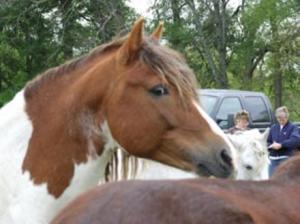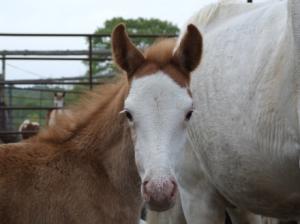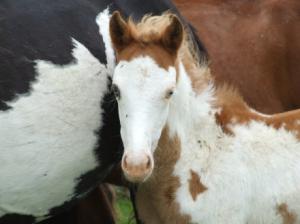Information from Jerry Self
The story of the Cherokee Horse begins with the Spanish explorers, who brought horses to the Americas beginning in the 1500s. It is speculated that the Desoto expedition left behind some of their Spanish horses, but the most agreed-upon theory is that the horses came from Mexico by way of the Indian trade routes, through the southwest continuing to the southeast. Another possible route is from Florida, from islands off the coast.
Native American Indians were very involved in the horse trade and all the southeastern tribes had horses (mostly derived from Spanish Mustangs). The Five Tribes (Cherokee, Choctaw, Chickasaw, Creek and Seminole) were breeding their own line of horses early on. These tribes traded horses with each other and bred to other tribes’ horses, making the breeds very similar.
The Chickasaw developed their own breed of horse, which was a very popular and sought after breed. This is likely where the Cherokee obtained their first horses. The Cherokee also acquired horses from the early settlers and other tribes through trade. The Chickasaw Horse was the beginning of the Quarter Horse, but was bred to extinction. The Seminole Ponies are still in Florida today, known by the name Florida Cracker Horse. The Choctaw Pony still exists today, being saved by a few breeders throughout the country. The Cherokee Horse is very close to extinction, with only a few left.
At the beginning of the 1830s, nearly 125,000 Native Americans lived on millions of acres of land in Georgia, Tennessee, Alabama, North Carolina and Florida--land their ancestors had occupied and cultivated for generations. But under Andrew Jackson’s Indian removal policy and the Indian Removal Act of 1830, the Five Tribes were forcibly removed from their homelands to Oklahoma “Indian Territory.”In the winter of 1831, under threat by the U.S. Army, the Choctaw became the first nation to be expelled from its land altogether. On this “Trail of Tears that left thousands of Native Americans dead, suffering from exposure, disease, and starvation, these are the horses that carried them.
In their new home, the remaining Cherokee, Chickasaw, and Choctaw continued breeding their horses. The Chickasaw Horses were eventually lost. All that remained were the Cherokee and Choctaw horses, with the majority being Choctaw. These horses roamed free on the open range for over 100 years in Indian Territory. A few families guarded their breeding and kept a watchful eye on their herd.
The Cherokee line that continues today is from the Whitmire family. This strain of Spanish Mustangs began in their original homeland, with Chief Old Tassell and passed down to the Whitmire family, who continued raising them until recently. The remaining horses were left in the care of the Rickmans of Soper, Oklahoms, who were entrusted with the Gilbert Jones herd (of “Hildago” fame) and continued the Choctaw breed with the remaining Choctaw and Cherokee horses.
Mr. Jewel G. Whitmire wrote “The 146 Year History of the ‘J’ Pony,” telling the history of how a Native American family’s horses with the bloodlines of the Cherokee Indian Ponies carried the same brand for 146 years. Mr. Whitmire’s ancestors were among the first to arrive in Oklahoma Territory, coming along the Trail of Tears from Echota, Georgia. He wrote: “We have one of the oldest Indian Pony bloodlines we’ve read or heard about. Our Cherokee family kept the foundation bloodline on the mares side, but occasionally bred some of the special mares to outstanding stallions.
“My grandmother’s people, Annie Corntassell-Whitmire, kept good ponies and brought them from the Carolinas to Indian Territory. We have records and the word of her granddad, Chief Old Tassell who had lots of ponies dating back to 1775.”
The major families that preserved the Choctaw horses were the Brame, Crisp, Locke, Self, Helms, Thurman, and Carter families. Jerry Self and his family have gathered a small herd and are now breeding Cherokee Horses at their End of the Trail Ranch in Enid, Mississippi. Today the Self Family, who are Cherokee descendants, has the highest percentage of the remaining Cherokee Horses. This small herd still runs free, and individuals are being bred to preserve the historic horses for the future.
Cherokee Horses are small compared to other breeds, but are not a pony breed. Averaging 14 to 14.2 hands, they are tough and hardy with strong feed and backs. Cherokee Horses come in a variety of colors, but most are pintos. Some are medicine hats, which are considered sacred by Native Americans, and only the bravest warrior was allowed to ride one. A very few are even curly. These horses are easy keepers, alert, and intelligent, with a smooth gait. The Cherokee breed is registered with the Southwest Spanish Mustang Association and can also be registered with the American Indian Horse Registry and the Horse of America Registry. The American Livestock Breeds Conservancy recognizes the Cherokee Horse as a rare and endangered breed.
The Self family, Jerry, Tish, and Lee, are dedicated to the preservation of this rare breed. For more information, contact the Selfs at End of the Trail Ranch, Enid, MS.
Much more information about these horses and their Native American ancestry is available at these websites:
http://www.albc-usa.org/ChoctawRescue/crChoctawcherokeehorses.html
http://www.albc-usa.org/ChoctawRescue/crChoctawrescue.html
http://www.albc-usa.org/ChoctawRescue/crChoctawphotopage.html
http://www.nps.gov/trte/index.htmTrail of Tears
http://www.cherokee.org/AboutTheNation/History/TrailOfTears/Default.aspxThe Cherokee Nation, Trail of Tears
http://www.history.com/topics/trail-of-tearsHistory Channel Trail of Tears
(Photos by Jeannette Beranger, American Livestock Breeds Conservancy)
The story of the Cherokee Horse begins with the Spanish explorers, who brought horses to the Americas beginning in the 1500s. It is speculated that the Desoto expedition left behind some of their Spanish horses, but the most agreed-upon theory is that the horses came from Mexico by way of the Indian trade routes, through the southwest continuing to the southeast. Another possible route is from Florida, from islands off the coast.
Native American Indians were very involved in the horse trade and all the southeastern tribes had horses (mostly derived from Spanish Mustangs). The Five Tribes (Cherokee, Choctaw, Chickasaw, Creek and Seminole) were breeding their own line of horses early on. These tribes traded horses with each other and bred to other tribes’ horses, making the breeds very similar.
The Chickasaw developed their own breed of horse, which was a very popular and sought after breed. This is likely where the Cherokee obtained their first horses. The Cherokee also acquired horses from the early settlers and other tribes through trade. The Chickasaw Horse was the beginning of the Quarter Horse, but was bred to extinction. The Seminole Ponies are still in Florida today, known by the name Florida Cracker Horse. The Choctaw Pony still exists today, being saved by a few breeders throughout the country. The Cherokee Horse is very close to extinction, with only a few left.
At the beginning of the 1830s, nearly 125,000 Native Americans lived on millions of acres of land in Georgia, Tennessee, Alabama, North Carolina and Florida--land their ancestors had occupied and cultivated for generations. But under Andrew Jackson’s Indian removal policy and the Indian Removal Act of 1830, the Five Tribes were forcibly removed from their homelands to Oklahoma “Indian Territory.”In the winter of 1831, under threat by the U.S. Army, the Choctaw became the first nation to be expelled from its land altogether. On this “Trail of Tears that left thousands of Native Americans dead, suffering from exposure, disease, and starvation, these are the horses that carried them.
In their new home, the remaining Cherokee, Chickasaw, and Choctaw continued breeding their horses. The Chickasaw Horses were eventually lost. All that remained were the Cherokee and Choctaw horses, with the majority being Choctaw. These horses roamed free on the open range for over 100 years in Indian Territory. A few families guarded their breeding and kept a watchful eye on their herd.
The Cherokee line that continues today is from the Whitmire family. This strain of Spanish Mustangs began in their original homeland, with Chief Old Tassell and passed down to the Whitmire family, who continued raising them until recently. The remaining horses were left in the care of the Rickmans of Soper, Oklahoms, who were entrusted with the Gilbert Jones herd (of “Hildago” fame) and continued the Choctaw breed with the remaining Choctaw and Cherokee horses.
Mr. Jewel G. Whitmire wrote “The 146 Year History of the ‘J’ Pony,” telling the history of how a Native American family’s horses with the bloodlines of the Cherokee Indian Ponies carried the same brand for 146 years. Mr. Whitmire’s ancestors were among the first to arrive in Oklahoma Territory, coming along the Trail of Tears from Echota, Georgia. He wrote: “We have one of the oldest Indian Pony bloodlines we’ve read or heard about. Our Cherokee family kept the foundation bloodline on the mares side, but occasionally bred some of the special mares to outstanding stallions.
“My grandmother’s people, Annie Corntassell-Whitmire, kept good ponies and brought them from the Carolinas to Indian Territory. We have records and the word of her granddad, Chief Old Tassell who had lots of ponies dating back to 1775.”
The major families that preserved the Choctaw horses were the Brame, Crisp, Locke, Self, Helms, Thurman, and Carter families. Jerry Self and his family have gathered a small herd and are now breeding Cherokee Horses at their End of the Trail Ranch in Enid, Mississippi. Today the Self Family, who are Cherokee descendants, has the highest percentage of the remaining Cherokee Horses. This small herd still runs free, and individuals are being bred to preserve the historic horses for the future.
Cherokee Horses are small compared to other breeds, but are not a pony breed. Averaging 14 to 14.2 hands, they are tough and hardy with strong feed and backs. Cherokee Horses come in a variety of colors, but most are pintos. Some are medicine hats, which are considered sacred by Native Americans, and only the bravest warrior was allowed to ride one. A very few are even curly. These horses are easy keepers, alert, and intelligent, with a smooth gait. The Cherokee breed is registered with the Southwest Spanish Mustang Association and can also be registered with the American Indian Horse Registry and the Horse of America Registry. The American Livestock Breeds Conservancy recognizes the Cherokee Horse as a rare and endangered breed.
The Self family, Jerry, Tish, and Lee, are dedicated to the preservation of this rare breed. For more information, contact the Selfs at End of the Trail Ranch, Enid, MS.
Much more information about these horses and their Native American ancestry is available at these websites:
http://www.albc-usa.org/ChoctawRescue/crChoctawcherokeehorses.html
http://www.albc-usa.org/ChoctawRescue/crChoctawrescue.html
http://www.albc-usa.org/ChoctawRescue/crChoctawphotopage.html
http://www.nps.gov/trte/index.htmTrail of Tears
http://www.cherokee.org/AboutTheNation/History/TrailOfTears/Default.aspxThe Cherokee Nation, Trail of Tears
http://www.history.com/topics/trail-of-tearsHistory Channel Trail of Tears
(Photos by Jeannette Beranger, American Livestock Breeds Conservancy)














